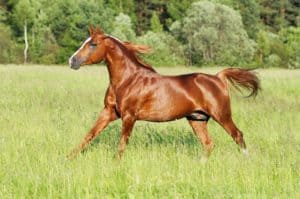Dynamic Endoscopy to Assess Equine Airway Function

A horse inhales approximately 3.5 liters per second (L/s) of air at rest and a staggering 70 L/s at maximum exertion. To put this in perspective, two industrial-sized vacuum cleaners would be required to generate the 70 L/s of airflow a horse is capable of producing while galloping. Given this tremendous flow rate, the soft tissue structures comprising the equine upper airway experience significantly increased forces during exercise. This difference in resting and exercising forces causes the upper airway tissues to appear anatomically normal at rest, even if they’re functioning abnormally during exercise. To fully diagnose upper airway dysfunction during exercise, veterinarians rely on dynamic endoscopy.
History
Veterinarians first began performing upper airway endoscopic exams on exercising horses in the late 1980s and ’90s using equine high-speed treadmills originally developed for locomotive and cardiovascular research and flexible endoscopes used in human medicine. High-speed treadmill endoscopy quickly became available in research institutions and limited private practices. However, expensive equipment, horse safety issues, and the inability to recreate the performance requirements of ridden horses limited its broad use in equine medicine.
During these high-speed treadmill exams, practitioners were able to spot cases of dynamic upper airway collapse that appeared normal on resting endoscopy. Research throughout the 1990s made it abundantly clear that dynamic endoscopy was necessary to accurately diagnose dynamic upper airway collapse. The advent of flexible videoendoscopes, LED light sources, and smaller video recording equipment made the development of the dynamic videoendoscope possible in the mid-2000s. A videoendoscope a horse could wear under saddle or harnessed immediately removed all limitations inherent to the high-speed treadmill. Veterinarians could now examine any horse’s upper airway while the animal performed its actual job at any location.
High-speed treadmills taught veterinarians the importance of dynamic endoscopy, but portable overground videoendoscopes made it widely available.
Current technology
The dynamic videoendoscopes currently in use allow veterinarians to perform videoendoscopy in nearly any exercise environment, including racing (flat and harness), jumping, dressage, driving, and polo. The equipment is lightweight, and veterinarians can quickly and easily place it on a horse minutes before exercise. Video of the upper airway is both permanently recorded and transmitted wirelessly to the veterinarian, allowing real-time observation of the upper airway during an exam. This is particularly useful because some horses only experience dynamic upper airway collapse when certain riding or driving aids are applied or in certain race situations. This is one of the main advantages overground endoscopy offers, as these conditions cannot be recreated on a treadmill or in a stall.
Dynamic obstructions
Left recurrent laryngeal neuropathy (“roaring”) is the dynamic obstruction veterinarians most commonly observe. Progressive neuropathy of the left laryngeal nerve results in atrophy (wasting) and loss of function of the small laryngeal muscle responsible for abducting (opening) the left arytenoid cartilage. Veterinarians might note left arytenoid cartilage dysfunction or paresis (partial paralysis) at rest; however, they can only observe significant airflow restrictive collapse of the left arytenoid and associated structures during exercise.
Intermittent dorsal displacement of the soft palate (iDDSP) is an expiratory obstruction that often produces a low-pitched gurgling noise during exercise. There is no correlation between the normal occasional DDSP observed at rest and the pathologic (dysfunction-causing) iDDSP observed during exercise. The condition typically only occurs under certain dynamic conditions such as poll flexion in sport horses and inside track position in racehorses.
Aryepiglottic fold collapse, vocal fold collapse, epiglottic retroversion, intermittent epiglottic entrapment, and dynamic pharyngeal collapse are among the other somewhat less commonly observed dynamic upper airway obstructions. Horses with these conditions appear entirely normal on resting endoscopy.
Take-home message
If a horse shows signs of poor performance or upper respiratory noise, the veterinarian should first scope the animal at rest. If he or she can’t make a definitive diagnosis on resting endoscopy, then the next step is a dynamic endoscopic exam to further assess upper airway function during exercise. An accurate diagnosis is essential to maximize treatment success.
Written by:
David T. Priest, DVM
Related Articles
Stay on top of the most recent Horse Health news with












